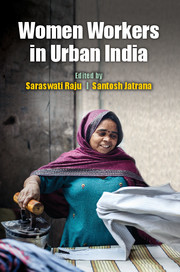Book contents
- Frontmatter
- Contents
- List of Figures
- List of Tables
- Preface
- 1 Setting the Backdrop
- 2 Women Workers in Urban India and the Cities
- 3 Gendered Vulnerabilities: Work-Life Trajectories of Female Domestic Workers in Jaipur
- 4 Occupational Domestication in a Post-Resettlement Context: An Analysis of Women's Work in Kannagi Nagar, Chennai
- 5 Old Jobs in New Forms: Women's Experiences in the Housekeeping Sector in Pune
- 6 Persistent Inequalities and Deepened Burden of Work? An Analysis of Women's Employment in Delhi
- 7 Spare Change for Spare Time? Homeworking Women in Banaras
- 8 Gender, Work and Space: Home-based Workers in Garment Industry in Kolkata
- 9 Labour Control and Responses: Women Workers in an Apparel Park in Kerala
- 10 New Urban Economic Spaces and the Gendered World of Work in Kolkata
- 11 Gender Equality and Women's Employment in the Banking Sector in India
- 12 Women Body Screeners and the Securitization of Space in Indian Cities
- Notes on Contributors
- Index
6 - Persistent Inequalities and Deepened Burden of Work? An Analysis of Women's Employment in Delhi
Published online by Cambridge University Press: 05 May 2016
- Frontmatter
- Contents
- List of Figures
- List of Tables
- Preface
- 1 Setting the Backdrop
- 2 Women Workers in Urban India and the Cities
- 3 Gendered Vulnerabilities: Work-Life Trajectories of Female Domestic Workers in Jaipur
- 4 Occupational Domestication in a Post-Resettlement Context: An Analysis of Women's Work in Kannagi Nagar, Chennai
- 5 Old Jobs in New Forms: Women's Experiences in the Housekeeping Sector in Pune
- 6 Persistent Inequalities and Deepened Burden of Work? An Analysis of Women's Employment in Delhi
- 7 Spare Change for Spare Time? Homeworking Women in Banaras
- 8 Gender, Work and Space: Home-based Workers in Garment Industry in Kolkata
- 9 Labour Control and Responses: Women Workers in an Apparel Park in Kerala
- 10 New Urban Economic Spaces and the Gendered World of Work in Kolkata
- 11 Gender Equality and Women's Employment in the Banking Sector in India
- 12 Women Body Screeners and the Securitization of Space in Indian Cities
- Notes on Contributors
- Index
Summary
Introduction
The capital city of Delhi with its neighbouring and growing satellite hubs such as Gurgaon and New Okhla Industrial Development Authority (henceforth NOIDA) offer varied and increasing possibilities for work, which is evident from the constant stream of in-migrants to the city. However, one of the most important trends, which has occasionally but casually been highlighted in the discussion on the city is the low participation of women in economic activities. The statistics on this aspect itself is shocking, given the expansion of service-oriented industries in recent years, which are often assumed to attract a large number of women. The data also indicate much deeper issues — of the nature and the gendered specificities of employment created, reflecting the existing notions and understanding of women's work both within the family as well as at work places. Sectoral/occupational concentration of women is universal and given this, the changing structure of employment would undoubtedly define the workforce in terms of gender. Alongside gender, social and demographic factors are also critical in determining as to who gets employed in various sectors/occupations. Thus, even within the overall poor participation of women, there are sectors or occupations where women's shares are higher or lower, or where women from a certain section of the population are more, indicating the larger social and economic factors that determine women's entry into paid work. These concentrations also indicate the gendered stereotyping of labour markets, which in turn are often based on the patriarchal notions of women's work — highly anchored in their role in social reproduction.
In more contemporary context, the liberalized economic regime, underlined by the growth of modern service sectors with gendered notions of skills skewed in favour of women, has resulted in an expansion of women's participation in the labour market in many countries of the world. The education and skill characteristics of these workers are often assumed to have further enhanced the positive vibes in the labour market with better wages, working conditions and renegotiation of women workers rights. This economic attainment alongside their social capital could pose challenges to existing power structures, questioning gender relations both at the workplace as well as at the individual level.
- Type
- Chapter
- Information
- Women Workers in Urban India , pp. 139 - 163Publisher: Cambridge University PressPrint publication year: 2016

